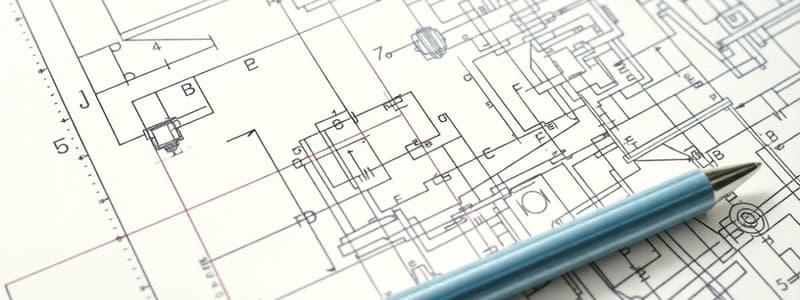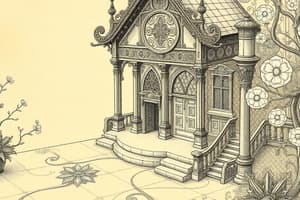Podcast
Questions and Answers
What does a partial view represent?
What does a partial view represent?
- Only the portions of the part that need clarification (correct)
- A full view with detailed features
- An object with symmetry only
- Both halves of an object
A half view only illustrates the entirety of a part.
A half view only illustrates the entirety of a part.
False (B)
What is the primary function of a local view?
What is the primary function of a local view?
To show only the features that need clarification.
A(n) ______ view can be created by rotating the features of an object about the symmetry axis.
A(n) ______ view can be created by rotating the features of an object about the symmetry axis.
Match the type of view with its definition:
Match the type of view with its definition:
Which view is advisable to represent symmetrical positioned features?
Which view is advisable to represent symmetrical positioned features?
A symmetry symbol is always used in half views.
A symmetry symbol is always used in half views.
What type of line acts as a symmetry axis in a half view?
What type of line acts as a symmetry axis in a half view?
What is the purpose of convention practices in orthographic writing?
What is the purpose of convention practices in orthographic writing?
An aligned view is a type of convention practice in orthographic writing.
An aligned view is a type of convention practice in orthographic writing.
Name one type of convention practice that involves the adjustment of views to save drawing space.
Name one type of convention practice that involves the adjustment of views to save drawing space.
In an incompleted side view, features that cannot be clearly seen from a selected viewing direction are __________.
In an incompleted side view, features that cannot be clearly seen from a selected viewing direction are __________.
Which of the following is NOT a type of convention practice?
Which of the following is NOT a type of convention practice?
Match the types of convention practices with their descriptions:
Match the types of convention practices with their descriptions:
Using a dash line represents a hidden edge in orthographic projection.
Using a dash line represents a hidden edge in orthographic projection.
The purpose of convention practices includes reducing __________ effort.
The purpose of convention practices includes reducing __________ effort.
What does an aligned view of holes give the impression of?
What does an aligned view of holes give the impression of?
An enlarged view is drawn at a smaller scale than the full view.
An enlarged view is drawn at a smaller scale than the full view.
What is the purpose of applying an aligned convention in orthographic projections?
What is the purpose of applying an aligned convention in orthographic projections?
An enlarged view must specify both the ______ and scale used.
An enlarged view must specify both the ______ and scale used.
Match the following terms with their definitions:
Match the following terms with their definitions:
When is it necessary to show non-existing lines of intersection?
When is it necessary to show non-existing lines of intersection?
The name of the enlarged view is optional.
The name of the enlarged view is optional.
What represents the term 'aligned convention' in orthographic views?
What represents the term 'aligned convention' in orthographic views?
Flashcards
Enlarged View
Enlarged View
An enlarged view is a detailed drawing of a specific part of an object, shown at a larger scale than the main view. It's typically framed by a thin line and labelled with its name and the scaling factor.
Non-existing Line of Intersection
Non-existing Line of Intersection
A non-existing line of intersection represents the line where two surfaces would intersect, even though those surfaces are actually rounded or filleted. It's used to show the true shape of the object, even when rounded edges obscure the intersection.
Convention Practice
Convention Practice
A commonly accepted practice in orthographic projection that deviates from strict rules to improve clarity and readability.
Purposes of Convention Practice
Purposes of Convention Practice
Signup and view all the flashcards
Alternate Position of Side View
Alternate Position of Side View
Signup and view all the flashcards
Incompleted Side View
Incompleted Side View
Signup and view all the flashcards
Partial View
Partial View
Signup and view all the flashcards
Half View
Half View
Signup and view all the flashcards
Local View
Local View
Signup and view all the flashcards
Aligned View
Aligned View
Signup and view all the flashcards
Combined left and right side views
Combined left and right side views
Signup and view all the flashcards
Convention for symmetrical features
Convention for symmetrical features
Signup and view all the flashcards
Line of symmetry
Line of symmetry
Signup and view all the flashcards
Symmetry symbol
Symmetry symbol
Signup and view all the flashcards
Study Notes
Chapter 5: Convention Practice in Orthographic Writing
- This chapter discusses conventions in orthographic writing, which are commonly accepted practices that help to simplify and clarify technical drawings. These practices disregard some strict rules of orthographic projection.
Topics
-
Definition: Conventions are commonly accepted practices that disregard some strict rules of orthographic projection, for more readable and easily understood technical drawings. They aim to improve representation of objects.
-
Purposes:
- Improve clarity of drawings
- Simplify dimensioning
- Reduce drafting effort
- Save or efficiently use drawing space
-
Types of Conventions:
- Alternate position of side view: Used to save space when an object's height is small compared to its depth, the side view is placed beside the top view.
- Incomplete view:
- Incomplete side views: Side views that omit features not clearly visible from the selected viewing direction.
- Partial view: A view representing only portions of a part, necessary for clarification.
- Half view: A partial view illustrating only half of the part.
- Local view: A view showing only features requiring clarification.
- Aligned view: A view obtained by imagining the object's features rotating about a symmetry axis. Shows features in a principle view.
- Enlarged view: A portion of a full view that is drawn with a larger scale. Clearly identifiable by a name and a specific scale
- Non-existing intersection line: The line of intersecting surfaces is eliminated by fillets or rounds; however, the projection lines are shown as if the fillets and rounds were not present, even though they are.
- Intersection (Hole on a cylinder): True projection representation when holes are large. When holes are small, simplified convention is used.
Examples
- Already met convention practice: A dash line represents a hidden edge, simplifying the view.
- Multiple examples of specific types of conventions (aligned, partial, half, etc.): Demonstrates these practices using specific technical diagrams/drawings. These examples include, holes, ribs, and keyways.
Studying That Suits You
Use AI to generate personalized quizzes and flashcards to suit your learning preferences.




